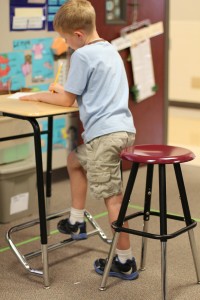
Photo: Darrinhenry | Dreamstime.com
Getting children to pay attention in class for long periods is a challenge for any teacher, but what if there was a simple way to help maintain their interest in what’s being taught? According to a recent study, allowing kids to stand at their desks instead of always sitting down could be the answer.
In a paper authored by Mark Benden, associate professor, and others from Texas A&M University, and published in the International Journal of Health Promotion and Education, the researchers observed that students who attended classes with standing desks showed a 12% increase in their levels of engagement compared to students in regular classrooms. This translates to about seven extra minutes per hour that children using standing desks were engaged in the instruction. This can have an impact on students’ performance. “Considerable research indicates that academic behavioral engagement is the most important contributor to student achievement,” said Benden.

Image courtesy Stand2Learn/PositiveMotion LLC
Standing desks allow kids to either sit or stand while using them. These desks are at a higher level than regular ones and have appropriately high stools to sit on, allowing children to either sit or stand, depending on their wants. Benden thinks that standing desks give children an outlet for their restlessness, thereby reducing disruptive behaviour and increasing their attention span. This also ties in to other research showing that some children need to move about in order to learn.
The study involved about 300 schoolchildren from classes 2 to 4. Their engagement in the classroom was observed throughout the school year and measured by ‘on-task’ behaviors such as answering a question, raising a hand or participating in active discussion and ‘off-task’ behaviors like talking out of turn.
Benden, whose background is in ergonomic engineering, has conducted other studies in the past that showed that standing desks can help limit obesity. In one of his previous studies, it was found that children at standing desks burn 15% more calories than students at traditional desks. Obese children burned 25% more calories.
There is some research evidence that increased mental performance goes hand-in-hand with even mild physical activity. “Simply put, we think better on our feet than in our seat,” said Benden.
The idea seems worth considering for schools even in India, since childhood obesity is on the rise here as well. After all, if standing desks benefit childrens’ health and their academic achievement, what could be the objection?
Benden is also one of the founders of PositiveMotion, LLC, which markets the Stand2Learn Desk in the US.
Do you think your child’s school should get standing desks? Leave a comment below. Please like FamiLife’s page on Facebook so that you get all our articles and others may find us.
